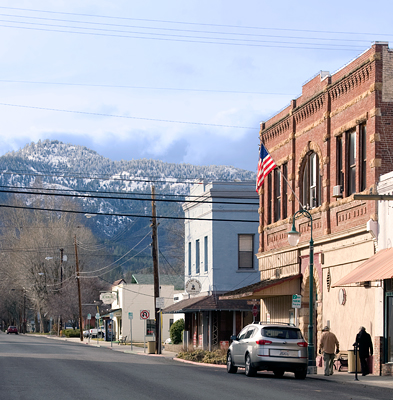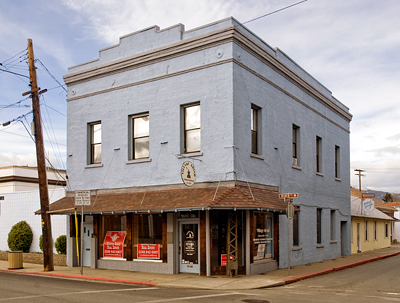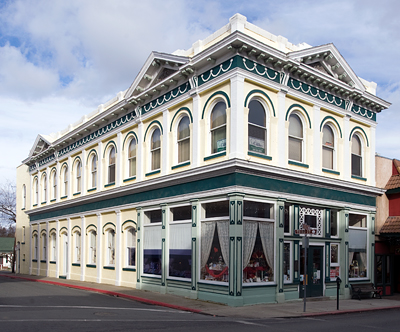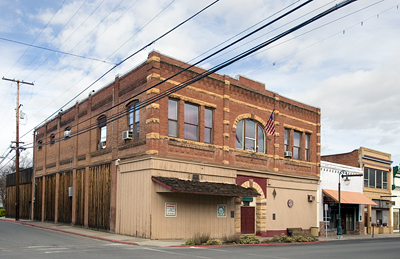National Register of Historic Places in Siskiyou County
West Miner Street Historic District
Yreka
The West Miner Street Historic District which covers 164 acres and contains seven contributing buildings is also California Historical Landmark 901.
Descriptions of the buildings pictured here are taken from interpretive plaques mounted on the buildings.
| Name | Year | Address | Remarks | Sort Address | Sort Name |
|---|---|---|---|---|---|
| Chamberlain-Stimmel Building | 1856 | 400-402 West Miner | Miner 400 | Chamberlain-Stimmel Building | |
| Charles Fry Home | 1899 | 216 Third Street | 03 216 | Charles Fry Home | |
| Franco American Hotel | 1855 | 306-316 West Miner | Miner 306 | Franco American Hotel | |
| Judge Rosborough Home | 1861 | 301 Third Street | 03 301 | Judge Rosborough Home | |
| Peters & DeWitt Building | 1897 | 330-332 West Miner | Elks Club | Miner 330 | Peters & DeWitt Building |
| Robert Nixon, Jr. Home | 1867 | 325 Third Street | 03 325 | Robert Nixon, Jr. Home | |
| Guilbert Building | 1900 | 216 West Miner | Gilbert Building | Miner 216 | Guilbert Building |
H. E. Stimmel, a German native, purchased this building from William Chamberlain in 1856, and promptly opened a stove shop. Initially selling parlor and cooking stoves, he gradually expanded his inventory and turned the business into a general hardware store. Shortly after the turn of the century, Mr. Stimmel passed on. The building was sold, renovated with a glass and iron front, and became a grocery, confectionary, and fruit store. Upstairs provided space for the News, a competitive newspaper. In more recent years the building housed a bakery, mortuary, art gallery, and clothing store. Note the tin ceiling that has been restored and meticulously painted.
From a narrow, two story brick house in the 1850s, to an expansive hotel with 167 foot frontage, the Franco American Hotel became one of the largest and finest inns in Northern California. Started by the Frenchman Leon Marniesse in 1855, the hotel housed a restaurant, Wells Fargo & Company Express Office, saloon and other businesses, and was a well-known stage stop. Through the years improvements consisted of a "piazza" or balcony across the front, additional suites of sleeping rooms upstairs and a two-story brick dining room. Among prominent guest were Vice President Colfax, General & Mrs. Philip Sheridan and President Hayes.
Donated by E Clampus Vitus, Humbug Chapter No. 73
(Siskiyou County Bank Building)
The Italianate-style building was put up after the fire of 1871 burned an earlier 1850s structure. Rebuilt in brick, the rear was used as a soda factory while the front became an auction house and later a space for county fair exhibits. The building's banking tradition began in 1886 when the Siskiyou County Bank and Wells Fargo & Company Express Agency moved in. In 1899, a totally remodeled building with the addition of a second floor was eventually leased for law offices which conducted business until 1968. The Miner Street level housed numerous banking operations until the last, Bank of America, vacated in 1955.
330 West Miner
Two buildings rested on this site in the 1850s, one a brewery and the other a bakery that advertised 12 loaves of bread for $1.00. Fire broke out in the bakery in 1864 destroying all of its contents and much of the surrounding structures. The brewery, however, reopened a week later. Other businesses, including a photographic studio, opened and closed until 1897 when Godfrey Peters and Robert DeWitt constructed a new two-story Richardsonian Romanesque-inspired brick and stone building on the lot. DeWitt's Bee Hive grocery store moved in the downstairs corner while the upper story served as the Knights of Pythias lodge and several dentists' parlors. The Benevolent and Protective Order of Elks bought the building in 1960.
332 West Miner
Godfrey Peters converted the east half of this building into a theater in 1904. The Peter's Opera House, complete with sloped floor, stage and two balconies, opened to a packed house with the showing of a five-act play. A bandstand was built over th sidewalk for outdoor music and a speaker forum. The Home Market purchased the theater in 1946 and renovated it to expand their grocery business. When the Elks purchased the building in 1960, this half of the downstairs was remodeled into a banquest hall.




